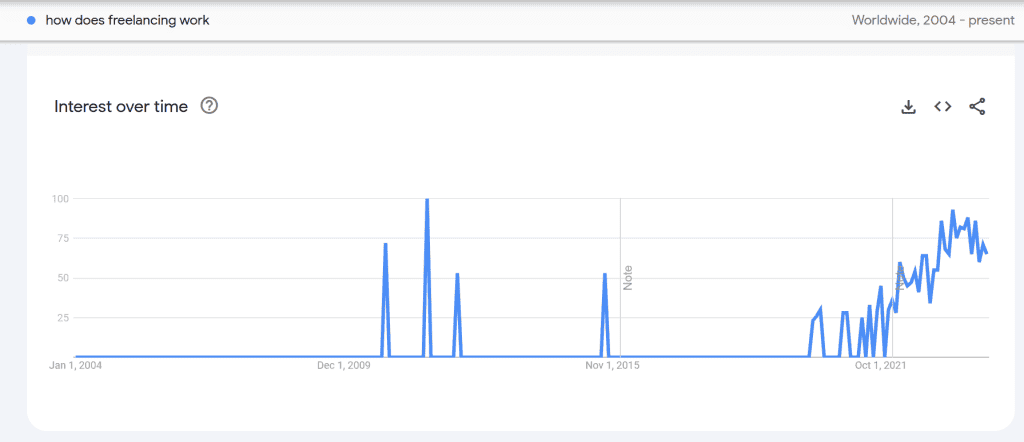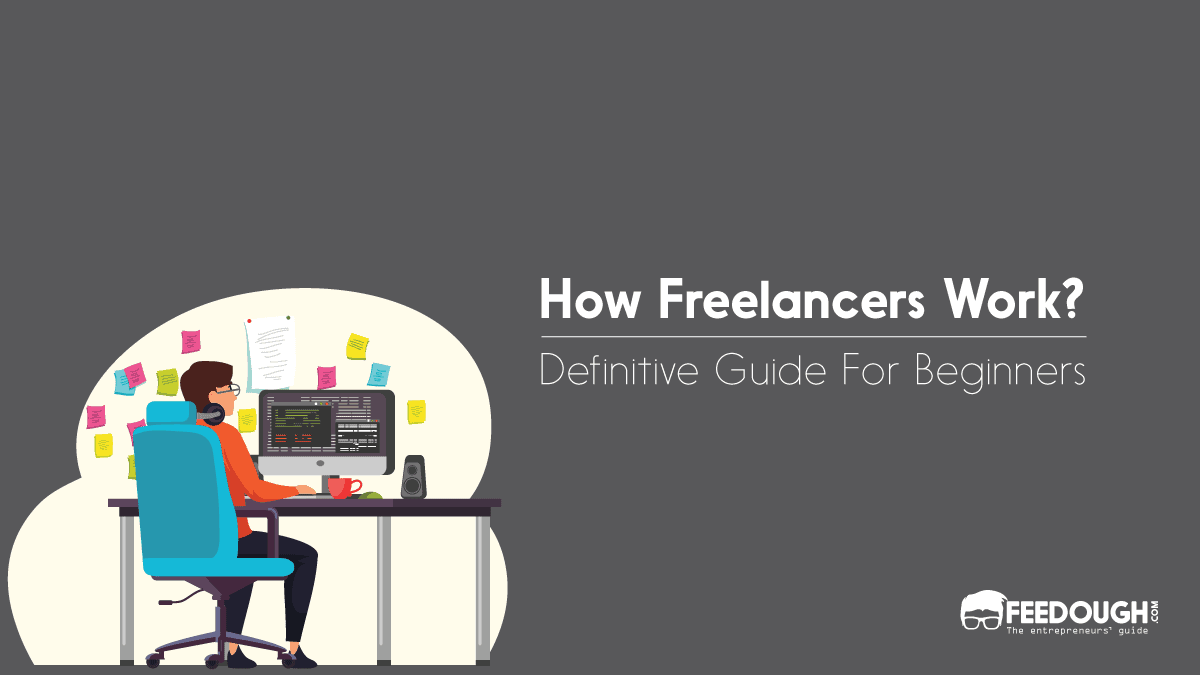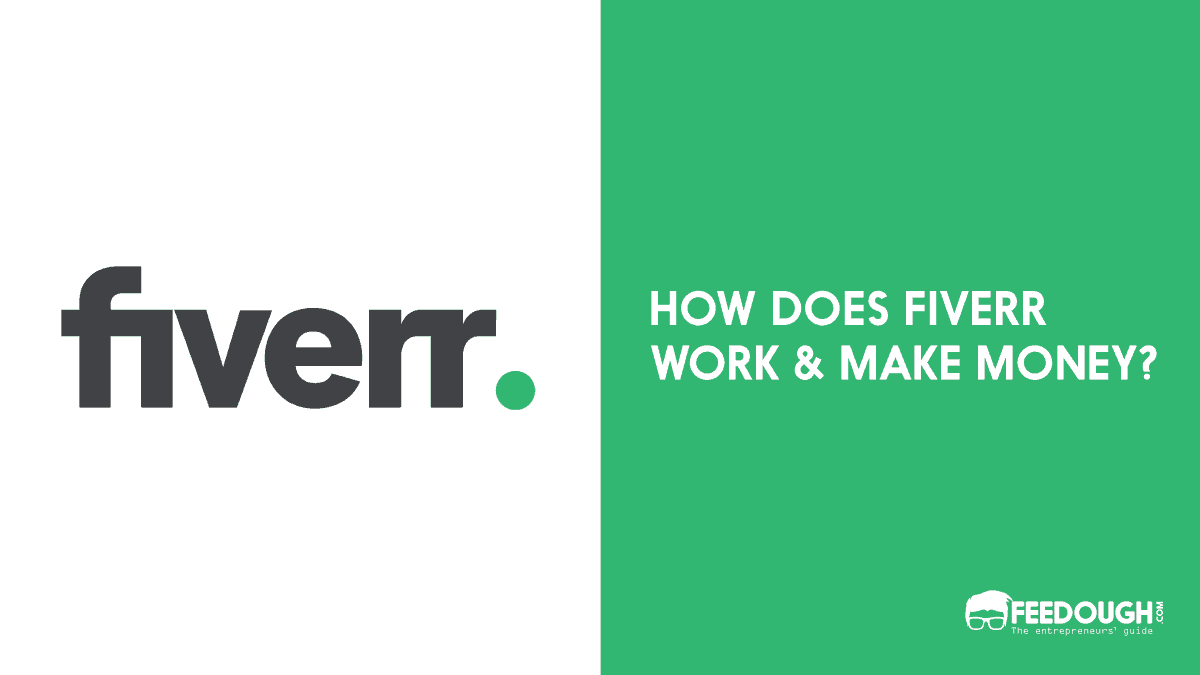You may often wonder how your freelancer friend earns a living or how people can do freelance work full-time. Even if you want to get into freelancing yourself, there are some things you might want to know about how freelancing works.
You’re not alone. Freelancing has indeed emerged as a popular career trend in recent years – thanks to the flexible working hours, location independence and the possibility of being your own boss.

But is it really that easy?
Let’s dig a little deeper into how freelancing actually works.
But for those who are completely unaware of freelancing, let’s start with the basics.
What Is Freelancing?
Freelancing is a type of work arrangement where an individual offers their services to (multiple) clients on a project basis rather than being employed by a company.
These services can range from writing and graphic design to consulting and virtual assistance. Freelancers are essentially self-employed individuals who market their skills and services to multiple clients.
As a freelancer, you are responsible for finding your own clients, setting your rates, managing your time and completing the projects on schedule.
In other words, you run your mini-brand.
Freelancing vs Traditional Employment
The main difference between freelancing and traditional employment is the level of flexibility.
As a freelancer, you typically work on a project basis for various clients, which means you have the freedom to choose your clients and projects.
In contrast, traditional employment involves working for one employer on a fixed schedule and being paid a regular salary.
Additionally, freelancers often have more control over their workload, work location and working hours.
However, this also means that freelancers may not have the same level of job security and benefits as traditional employees.
Basis of Comparison | Freelancing | Traditional Employment |
|---|---|---|
Definition | Working independently on projects for various clients. | Working as an employee for a single employer, often full-time. |
Work Schedule | Flexible hours, chosen by the freelancer. | Fixed hours, determined by the employer. |
Location | Usually remote, can work from anywhere. | Typically at the employer’s office or specified workplace. |
Job Security | Less stable, depends on finding clients and projects. | More stable, with a consistent salary and job duration. |
Income | Variable, depends on the number and type of projects. | Fixed, regular salary or wage. |
Benefits | Generally, none provided; self-arranged (health insurance, etc.) | Often includes benefits like health insurance, retirement plans. |
Tax Responsibility | Freelancer handles their own taxes. | Employer withholds taxes from the paycheck. |
Career Growth | Self-driven, based on networking and skill development. | Often structured, with clear paths for promotion and development. |
Work-Life Balance | Potentially better, but depends on managing workload. | Structured hours may help, but less control over workload. |
Accountability | Directly to clients for deliverables and quality. | To managers or supervisors, following company policies. |
Professional Development | Self-motivated, must seek out own opportunities. | Often supported by employer, with training and development opportunities. |
How Does Freelancing Work?
A freelancer works like any other business owner. They have a specific set of skills and services that they offer to clients, and they are responsible for finding and managing those clients.
Finding The Niche
The first step to freelancing is identifying your marketable skills and services.
This could be anything from digital marketing to web development or translation services.
Once you have identified your skills, you find the demand for gigs related to those skills.
For example, if you’re a writer, you may specialise in copywriting, content writing or technical writing. Even in these subdomains, you may find different niches such as academic writing or marketing copywriting.
Once you have identified your niche and the type of services you offer, it’s time to build your portfolio.
Building The Portfolio
Your portfolio is the showcase of your work and clients, which helps potential clients understand your expertise and experience.
You usually create a portfolio from your previous projects and clients.
If you’re just starting, you can offer services to friends and family or take up small projects to build your portfolio.
Many freelancers even offer their services for really low prices or for free in the beginning to gain experience and credibility.
Once you have a well-established portfolio, it becomes easier to attract high-paying clients and establish yourself as an expert in your niche.
Finding Clients
One of the biggest challenges for freelancers is finding clients.
There are various ways to find clients, such as using online platforms like Upwork, Fiverr or Freelancer, networking through social media and attending events related to your niche.
Here are the five sources freelancers use to find clients:
Networking
Often, the best way to find clients is through networking.
This involves building relationships and connecting with other professionals or potential clients in your industry.
Freelancers usually attend industry events, join relevant online communities, and utilise social media platforms like LinkedIn and Twitter to network. They engage in conversations, share their work and expertise, and build a network of potential clients.
Even if the network may not directly lead to a client, it can still bring in referrals or recommendations from others in your network.
Online Freelancing Platforms
Several dedicated platforms like Upwork, Fiverr and Freelancer connect freelancers with potential clients.
These online platforms serve as a bridge connecting businesses or individuals in need of specific services with freelancers offering their expertise. You as a freelancer create a profile on these platforms and showcase your skills, experience, and rates.
Clients on the other hand post their projects and requirements, and then freelancers can bid on them. Sometimes, clients may also directly reach out to freelancers based on their profiles and portfolios.
Since these marketplaces work heavily on building their brand and getting clients, they can significantly help freelancers in finding new clients.
Platform | Niche/General | Notable Features for Freelancers |
|---|---|---|
General with a focus on creative, digital marketing, and tech services. | Offers services in more than 200 categories, enabling freelancers to sell a wide range of services starting at $5. | |
General | Provides a vast array of job categories from web development to customer service. Offers a work diary for hourly projects to ensure payment for logged hours. | |
High-end (Top 3% of freelancers) in finance, design, project management, and software development. | Focuses on connecting top-tier freelancers with enterprise and startup clients, offering high rates but requiring a rigorous screening process. | |
Design | Specializes in design work, allowing designers to participate in contests or work directly with clients on projects. |
Many freelancing platforms incorporate an escrow system to ensure the security of payments. They hold the client’s funds in escrow until the project is successfully completed, providing freelancers with assurance that they will be compensated for their work.
Referrals
Referrals are one of the most powerful ways for freelancers to find clients. When you provide excellent services and deliver high-quality work, satisfied clients are more likely to recommend you to others in need of similar services.
Word-of-mouth referrals can bring in a steady stream of new clients and also establish your credibility in the freelance industry.
It is important to maintain good relationships with your clients and provide exceptional services to increase the likelihood of receiving referrals.
Cold Pitching
Cold pitching involves reaching out directly to potential clients through emails or messages, even if they have not posted a job or project. This method requires research and personalisation as you need to tailor your pitch according to the needs of each potential client.
Here’s how a usual freelancer’s cold pitching process might look like:
- Identify potential clients and their needs. You do this by researching their company or industry and understanding their pain points.
- Craft a personalized pitch that highlights how your skills and services can solve their specific problems.
- Send out the pitch through email or direct message, keeping it concise and professional.
- Follow up if you don’t receive a response after a few days, but avoid being too pushy or aggressive.
While many freelancers prefer email outreach for cold pitching, some also utilize social media platforms like LinkedIn or Twitter to connect with potential clients.
How Do Freelancers Get Paid?
Freelancers can get paid in various ways, depending on their agreements with their clients. The way freelancers receive payment is determined by factors such as the nature of the work and the client’s preferences. Here are several payment options that freelancers commonly utilise:
- Hourly Rate: Some freelancers charge clients based on an hourly rate, where they track the time spent on a project and bill accordingly. Hourly rates are often used for services that involve ongoing work or long-term projects, such as consulting or virtual assistance. For example, if you are a developer and charge $50 per hour, working on a project for 10 hours would earn you $500.
- Project-based Fee: In this approach, freelancers quote a fixed price for the entire project based on their understanding of the workload and complexity. Project-based fees are common in creative industries such as graphic design or copywriting, where the deliverables are more tangible. For instance, you may charge $500 to design a logo for a client.
- Retainer Fee: In some cases, clients may retain the services of a freelancer for an agreed-upon period. The freelancer commits to providing a set number of hours or services each month, and the client pays a retainer fee. This arrangement is beneficial if the client needs ongoing support or regular availability from the freelancer. For example, Certain freelance lawyers or legal consultants offer retainer services to clients in need of ongoing legal advice and support. The client pays a monthly retainer fee, and in return, they have access to a specified number of hours or services from the freelancer, such as contract review, legal research, or consultation.
- Per-word or Per-page Rate: Many freelancers involved in writing, editing, or translation work charge clients based on the number of words written or pages edited. They have a specific rate for each word or page and calculate the total payment based on the volume of work. Let’s say a freelance editor charges $0.10 for each word and needs to edit an article of 1000 words. So, they’d be getting $100 after completing the project.
- Commission: Certain freelancers, such as sales professionals or affiliate marketers, earn through a commission-based model. They receive a percentage of the sales they generate or the leads they bring in for a client. For example, if they generate a sale of $1000 and the agreed commission is 10%, they’ll receive $100 as commission based on this model.
- Value-based Pricing: Some freelancers specialising in delivering high-impact results or solving specific problems may opt for value-based pricing. Instead of charging a fixed rate, they charge based on the value and benefits their work brings to the client’s business. For example, A freelance software developer who specialises in complex work may charge higher rates compared to other developers with similar experience who work fewer hours on more straightforward projects that are less important.
How Do Freelancers Retain Their Clients?
After the completion of the project, freelancers need to retain their current clients, as it is more cost-effective than constantly chasing after new clients and ensures future collaborations and client loyalty. Here are some strategies freelancers often use to retain their clients:
- Follow-up and Feedback: After completing a project, freelancers reach out to their clients to gather feedback on their experience and the results they achieved. This shows a commitment to continual improvement and allows freelancers to address any concerns the client may have. By actively seeking feedback, freelancers demonstrate their dedication to delivering high-quality work and their commitment to client satisfaction.
- Stay Connected: Maintaining regular contact with clients is essential for building a strong connection and retaining them for future collaboration. Freelancers usually check in periodically to see how their clients’ businesses are doing, offer assistance or insights, and remind them of their availability for any future projects.
- Provide Value-Added Services: Beyond the initial project, freelancers sometimes offer additional services or suggestions demonstrating their expertise and providing ongoing value to the client. This could include sharing industry insights, recommending improvements or strategies, or offering discounts for future work.
- Offering Incentives: Freelancers often provide incentives to reward client loyalty and incentivise them to keep working with them. These incentives may involve providing discounts for repeat business, offering referral bonuses, or granting exclusive access to special services.
What Are The Challenges Of Being A Freelancer?
While freelancing offers many benefits, such as a flexible work-life balance, the ability to choose clients and working hours, and the potential for unlimited income, it is important to consider that freelancing has its own challenges. Here are the major challenges of being a freelancer:
Income Inconsistency
Freelancers often experience inconsistency in their workload, which results in fluctuating income. At times, freelancers find themselves juggling multiple projects with a busy schedule and a steady income stream. Other times, however, they face periods with limited work opportunities. The irregularity of projects can lead to uncertainty and financial instability.
Lack of benefits
Unlike traditional employment, freelancers do not receive employer-based benefits like holiday pay, medical insurance, 401(k) contributions, and other common perks. Sick leave is non-existent, and insurance coverage needs to be acquired independently. Since freelancers don’t receive insurance and other benefits from clients, that’s why they need to look for affordable healthcare for self-employed individuals.
As self-employed individuals, freelancers don’t have paid time off for illness or holidays either. It becomes necessary for them to create a contingency plan in case of sickness, personal emergencies, or when they need to take a vacation and cannot effectively serve their clients or meet deadlines.
Not Getting Paid
As a freelancer, there is always the risk of encountering non-payment from clients, which is a common occurrence in the freelance industry. It is not uncommon for freelancers to encounter clients who delay payment, make partial payments, or refuse to pay altogether.
Dealing with non-paying clients requires freelancers to take on the role of debt collectors, which can be time-consuming and add additional stress to their workload.
Isolation and Limited Collaboration
Freelancing can be a solitary profession, lacking the daily interaction and collaborative opportunities found in traditional work environments. As a freelancer, there is a lack of daily interactions with managers, colleagues, and personnel that are usually found in a traditional employment setting. Working alone may lead to feelings of isolation and a lack of professional support and networking.
Freelancers mitigate this isolation by actively engaging in networking activities, joining professional associations, and fostering social connections. Social media platforms such as Twitter, LinkedIn, and Facebook offer valuable tools for connecting with others and overcoming the sense of isolation that freelancers may experience.
Work-Life Imbalance:
The flexibility that freelancing offers can also make it difficult to maintain a healthy work-life balance. Since freelancers choose their own work hours, it also means that they don’t have a predefined schedule or structure to ensure a healthy work-life balance.
Without the structure of a regular work schedule, it can be tempting to overwork or be constantly available to clients, leading to burnout and strained personal relationships. That’s why it becomes crucial for freelancers to establish a well-defined schedule to prevent themselves from constantly working and maintain a proper work-life balance.
Administrative Responsibilities
Freelancers typically have to manage various administrative tasks themselves, including invoicing, contract negotiations, and handling client relationships. This can be time-consuming and take away time from revenue-generating activities.
Moreover, freelancers often need to build their own resources and create a virtual library specific to their field of practice. This involves investing in resources such as databases, treaties, registration books, and computer research tools, which can be costly. Unlike traditional legal firms and employers, freelancers no longer have access to support staff like help desk personnel and network managers.
Uncertain Job Security
Freelancers face a higher level of job insecurity compared to employees. Projects may come to an abrupt end, clients may choose not to continue working with them, or competition for freelance work may increase. It becomes important for freelancers to continually market themselves, diversify their client base, and adapt to evolving industry trends.
Tax consequences
In freelancing, freelancers face the challenge of managing personal and professional tax complexities independently. Unlike traditional employment, where the company takes care of tax deductions automatically, as a freelancer, you are responsible for handling all the “money stuff” yourself.
As an independent contractor, freelancers are subjected to an additional self-employment tax. Therefore, they are responsible for paying estimated taxes every quarter if their tax liability for the year exceeds $1,000. That’s why freelancers need to keep meticulous records of all their expenses to ensure accurate reporting and maximise tax deductions.
FAQs
Freelancers usually communicate with clients through email, phone calls, video conferencing, or project management tools. Clear and timely communication is essential to establish expectations, clarify project details, and maintain a positive working relationship.
Freelancers need effective time management skills to balance multiple projects and meet deadlines. Tools such as project management software, to-do lists, and time-tracking apps help freelancers to stay organised and manage their workload efficiently.
Freelancers can determine their rates by considering factors such as their skills and expertise, market demand for their services, the complexity of the project, and their overhead costs. Researching industry standards and taking into account the value they offer helps them to set competitive rate
Wordsmith. Caffeine enthusiast. A full-time business-oriented writer with a knack for turning the ordinary into extraordinary. When not working, you can find Ishan listening to music, reading or playing with doggos.









